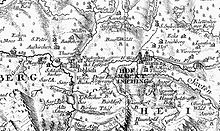Toblacher Feld
| Toblacher Feld (Toblacher Saddle) | |||
|---|---|---|---|
|
View over the Toblacher Feld towards the entrance of the Höhlenstein valley |
|||
| Compass direction | west | east | |
| Pass height | 1210 m slm | ||
| region | South Tyrol , Italy | ||
| Watershed | Silvesterbach / Rienz → Eisack → Etsch | Drau → Danube | |
| Valley locations | Toblach | San Candido | |
| particularities | Valley watershed | ||
| Map (South Tyrol) | |||
|
|
|||
| Coordinates | 46 ° 43 '37 " N , 12 ° 13' 22" E | ||
The Toblacher Feld ( Italian Conca di Dobbiaco ) is a valley widening at 1210 m slm height approximately in the middle of the Pustertal in South Tyrol ( Italy ), which runs in an east-west direction . Since - although situated on the valley floor - hydro geographically a watershed between the river system of the Adige , in the Adriatic flows, and that of the Danube , in the Black Sea is flowing, the area is also known as Toblacher saddle ( Sella di Dobbiaco referred) .

In the slopes a little east of the above-ground watershed - in the border area between the communities Toblach and Innichen - the source of the Drava is traditionally located, which flows from here further east to the Danube. At Toblacher Feld there are the entrances to two side valleys: In the north lies the Silvestertal , which is drained by the Silvesterbach, which flows into the Rienza ; the Rienza in turn reaches the Toblacher Feld from the south through the Höhlensteintal and turns here to the west, where it finally flows into the Eisack , a tributary of the Etsch, in the Brixen area . At the entrance of the Silvestertal is the center of the municipality of Toblach, at the entrance of the Höhlensteintal is the much younger New Toblach .
The Toblacher Feld has always been a traffic junction, because here in addition to the transport routes running in east-west direction (today primarily the SS 49 and the Pustertal Railway with the Dobbiaco station ) there is a route south (today the SS 51 ) into the Dolomites branches off. A high cross is mentioned as a landmark at the old crossing point as early as 1307 , which was destroyed several times over the centuries and was last rebuilt in 1987 near the Dobbiaco airfield .
Historically, the Toblacher Feld has come into focus three times in the course of its history. In the years around 600, the advance of the Slavs in the Puster Valley was stopped by the Bavarian Duke Tassilo I. Traces of Slavic settlement, for example in field names, traditional owner names and architectural features, find their westernmost distribution area in Tyrol in the Dobbiaco area . As a result of the Peace of Schönbrunn of 1809 and the Bolzano Protocol of 1810, which regulates further details, the area of the watershed acquired political importance, as the new border between the Illyrian provinces and the Kingdom of Bavaria was drawn between Toblach and Niederdorf to the west . In 1814 the entire Pustertal returned to the Austrian Empire . After the First World War , the Toblacher Feld was originally intended as a border with Austria in the course of efforts, especially promoted by Ettore Tolomei , to expand the Italian national territory to the watershed. Presumably for military and strategic reasons, the Italian military also occupied areas east of the saddle up to a narrow point between Winnebach and Sillian about ten kilometers further, with subsequent protests from Tolomei , where the state border was actually established in the 1919 Treaty of Saint-Germain .
literature
- Josef Rampold : Pustertal: Landscape, past and present on the Drau, Rienz and Ahr. Eastern South Tyrol between the Sexten Dolomites and Mühlbacher Klause (= South Tyrolean regional studies in individual volumes . Volume 2 ). Athesia, Bolzano 1972.
- Ludwig Walther Regele: Border issues on the watershed from Tassilo to Tolomei . In: Tirol to Isel and Drau: an approach (= Arunda ). tape 65 . Löwenzahn, Innsbruck 2005, ISBN 3-7066-2375-7 , p. 22-25 .
- Otto Stolz : History of the waters of Tyrol (= Schlern writings . Volume 32 ). Wagner, Innsbruck 1936, p. 104-105 .

